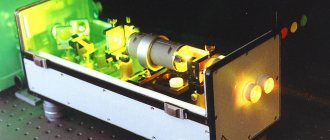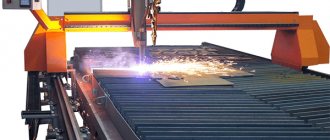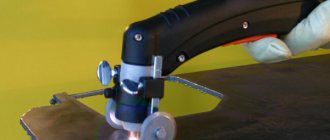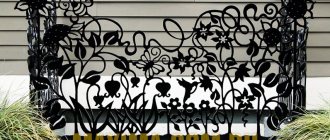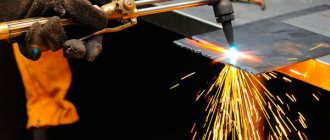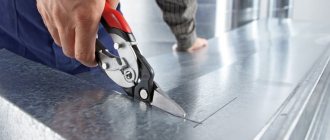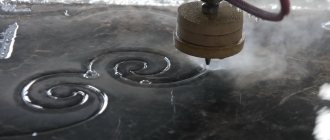Initially, people separated metal parts with hand tools. It was a slow process that required a lot of time and effort. The cut was often uneven and parts were rejected. With the development of technological progress, new ways of separating metal workpieces have emerged. Laser cutting is a modern method of processing metal parts.
Laser cutting
What equipment is used for laser cutting
Devices are classified according to various parameters. The basis is the working environment, which determines the laser source.
Laser cutting is performed by three types of devices:
- Solid State Systems.
A solid working fluid is built into the lighting module. A high-power gas-discharge lamp is also located there. The working material can be a ruby rod or neodymium glass. Along the edges of the rod there are mirrors: one is translucent, and the other is reflective. Due to multiple reflections, the laser beam created by the working fluid increases its power and exits through a translucent mirror. - Gas devices.
The operation of these units is based on the use of carbon dioxide, which can be used either together with nitrogen and helium, or separately. Carbon dioxide helps activate electric discharges, and two mirrors are also used to increase power. - Gas-dynamic devices.
These are the most high-power units. Their work is also based on the use of carbon dioxide, which is heated to temperatures from 726 to 2726 degrees. A low power laser beam is used for activation. As it passes through the nozzle, the state of the gas changes and it becomes a source of radiation. Gas-dynamic machines are the most expensive.
The type of laser cutting is determined by the type of material being processed.
Equipment that uses carbon dioxide can be used for welding, cutting and engraving plastic, metal or glass. Units with a solid-state type of operation are successfully used for cutting aluminum, brass, silver and copper. Not used for processing non-metal materials.
Purpose and selection criteria
This method of work is also used for processing plywood, linoleum, polypropylene, and rubber. Even artificial stone and glass can be subjected to this treatment. This type of cutting is used in the construction of cars, ships, numerous electrical appliances, as well as agricultural machines. This processing option is also suitable for making signs, signs, tokens, and interior decorative elements.
Laser cutting machine GCC LaserPro FMC280 200 W
- Dimensions, mm 1125 x 720 x 1800 mm
- Maximum power consumption 1800 W
- Display 4-line LCD panel
- Max. motor speed 500 mm/s
- Maximum load size 786 x 542 x 120 mm
- Laser tube power 200 W
- Memory capacity 32 MB
- Axes 3
- Emitter manufacturer Germany
- Working field 712 mm x 370 mm
- Resolution, DPI 3000
- Laser type: optical fiber 1070 nm
- Laser tube cooling type: air
Go to product
When choosing the type of processing, you need to rely on the material being processed. For example, carbon dioxide lasers are more suitable for welding, engraving and cutting metal, glass, rubber and plastic.
But solid-state machines process metal perfectly, but are not at all suitable for non-metals.
What determines the quality of laser cutting?
The concept of laser cutting quality presupposes the accuracy of the cut and the absence of roughness.
The following factors influence the result of work:
- Material of the part and its dimensions;
- Correct equipment setup;
- Technical serviceability of the machine;
- Precision in design development.
If all requirements are met, the cutting accuracy can be 0.1 mm.
The cutting speed is influenced by the power of the equipment, thermal conductivity and thickness of the workpiece. The higher these numbers, the faster the heat removal is performed, and the more energy is required to complete the task.
The cutting speed is influenced by the power of the equipment, thermal conductivity and thickness of the workpiece. The higher these numbers, the faster the heat removal is performed, and the more energy is required to complete the task.
What consumables are needed?
For plasma cutting machine
On plasma it is necessary to change nozzles, electrodes, protective screens, and casings. And on the laser there are only lenses and a nozzle.
For laser machine
But when working on a laser machine, it is necessary to change the lens and nozzle every two weeks. The lens costs 700 rubles, the nozzle costs 900 rubles.
The maximum monthly payment for consumables for a laser machine will be 3,200 rubles.
So let's summarize.
Features of laser cutting of certain metals
The choice of laser cutting technology depends on the properties of the material being processed. For processing non-ferrous metals or their alloys, equipment with a power of 1 kW or more is required. For ferrous metals, 0.5 kW will be sufficient.
In most cases, laser cutting using oxygen is used for cutting high-carbon steels.
The use of this method ensures acceptable cut quality.
Stainless steel workpieces are treated using nitrogen. It is supplied to the processing point under pressure of up to 15-20 atmospheres. For stainless and galvanized steel, given their strength, cutting with a laser beam is the optimal processing method while maintaining quality.
The processing of aluminum, brass and their alloys is carried out using nitrogen supplied to the processing point under pressure of up to 15-20 atmospheres.
Copper is characterized by high thermal conductivity. Taking this into account, sheets no thicker than 6 mm are used for cutting.
Good results were shown when using laser equipment for cutting pipes up to 30 mm thick. The cutting line can be made at any angle. The result is a flat surface, completely suitable for installation or welding.
What is meant by metal cutting?
Sheet metal cutting is a procurement operation. They are carried out with the aim of forming parts suitable for welding and installation. In essence, this is the production of fragments of metal structures. Enterprises often operate entire procurement departments where cutting, processing of cut edges, bending, etc. are performed. The result is either workpieces that require additional processing or finished parts. It all depends on what technologies and equipment are used at this stage.
Before cutting begins, you need to rationally place the “patterns” on the sheet. The workpiece can be of any shape, but the easiest way, of course, is to work with rectangular ones. During the cutting of sheet metal, waste is generated - returnable and non-returnable. The amount of these residues is directly related to the technology used.
We recommend articles on metalworking
- Steel grades: classification and interpretation
- Aluminum grades and areas of their application
- Defects in metal products: causes and search methods
Cutting sheet metal is a difficult and very responsible operation. The quality and cost of parts and the entire structure as a whole depends on it. Modern enterprises prefer efficient high-tech cutting methods.
Features of plasma cutting
This technology involves the use of a plasma jet as a cutting tool. The advantages of the method lie in the possibility of processing refractory and non-ferrous metals. In this case, it is possible to achieve the most complex cutting shape.
In terms of the quality of the edges formed, laser cutting shows better results than plasma cutting. After the laser, the edges are absolutely perpendicular.
If the thickness of the workpiece being processed is more than 16 mm in size, then the cutting process using plasma is faster and less energy-consuming than with a laser. As for thin workpieces, the laser shows higher efficiency. With its help, it is possible to cut the most complex geometric shapes and with maximum compliance with the technical specifications.
How to make a laser cutter in the garage
Laser cutting of steel is carried out using purchased and homemade devices. If you can’t buy a machine, you can make it yourself. To do this you need to prepare materials and tools:
- powerful battery-powered flashlight;
- laser pointer;
- DVD-ROM drive;
- soldering iron, screwdrivers.
Step-by-step instructions for assembling a laser cutter:
- Initially, you need to disassemble the drive to remove the working head. This must be done carefully so as not to damage the lens.
- Pull the diode out of the pointer. In its place, solder the working part from the drive.
- The insides of the pointer need to be pulled out to assemble a new housing for them. Secure all elements into the flashlight body. Remove the protective glass and power the device with batteries.
Additionally, you can strengthen the body with tape and glue.
Strengthening a homemade installation
Craftsmen experiment with a set of lenses to enhance the power of the beam. Additionally, you can power it from a battery charger. To make it more convenient to carry out technological processes, a structure is assembled to hold the homemade installation. It is installed above the desktop on guides.
Laser cutting is a modern technological process that allows you to separate metal sheets of different thicknesses. Depending on the size of the workpieces being processed, you need to select the drive power.
Features of gas cutting
The gas cutting process is carried out in the following way. Using propane or acetylene, the workpiece is heated to 1000-1200 degrees. Then the oxygen supplied to the heated surface ignites and cuts the metal. The method is applicable for processing parts whose combustion temperature is lower than the melting temperature. This can be steel containing low and medium alloying components.
The gas cutting method is low cost, and the equipment used is portable and easy to use.
The accuracy of gas cutting is much less than that of plasma or laser.
Complex production
Our production allows us to carry out full-cycle metal processing in one workshop:
- Laser, plasma and gas cutting - our production is equipped with all the necessary modern equipment for any type of cutting.
- Assembly of metal structures - welding work, assembly of structures of any complexity and volume.
- Metal bending with a maximum length of 2500 mm and positioning accuracy of +/- 0.2 mm.
- Assembly of screw piles, which are used in the construction of foundations for private houses, commercial and industrial facilities.
- Powder coating of metal structures to protect against corrosion and give an aesthetic appearance.
Features of waterjet cutting
Waterjet cutting is carried out using a mixture of water with the addition of abrasive particles. Silicon carbide, electrocorundum or garnet sand can be used as an abrasive. Water is supplied to the cutting head under a pressure of about 6000 atmospheres. Then, at a speed of 1000 meters per second, it is fed into the chamber with the abrasive, mixed with it, and the ready-made abrasive mixture cuts the metal and at the same time washes away the waste from the cutting process.
A distinctive feature of the waterjet process is the absence of heating of the treated surface.
There are a number of advantages to this:
- The use of waterjet cutting is suitable for processing any materials;
- Due to the absence of the process of melting and burning of the treated surface, the cut is perfect;
- Can be used for heat sensitive materials;
- There are no harmful emissions during operation;
- Complete fire safety of the work performed.
The disadvantages of the method include the low processing speed, in comparison with laser or plasma technology. Also, expensive equipment is used here, which results in a high cost of the process.
Among all the options presented, the laser cutting method is the most optimal.
This method, in addition to cutting, can be used for marking, engraving and marking metal products.
Practical application of laser cutting
Stages of production of products using laser equipment:
- The concept of the original product;
- Sketch formation;
- Layout construction;
- Making a sample on a CNC machine;
- Monitoring the results obtained and making improvements, if necessary;
- Launch of serial production.
Particular attention should be paid to the layout. The accuracy of its manufacture will fully influence the quality of the finished product.
The operation of the machines is based on data generated by AutoCAD software. Accordingly, drawings must be created using this program.
Technical requirements for layouts used in the laser cutting process:
- Contours must be made on a scale of 1:1;
- Closedness of internal and external contours;
- Lack of SPLINE and ELLIPSE graphic objects;
- It must be taken into account that when lines are superimposed on one another, the laser beam will pass along this path several times;
- The drawing must indicate the material used and the number of parts to be manufactured.
Advantages and disadvantages of laser technology
Laser cutting of metal has a number of significant advantages over other types of cutting. Here are a few of its advantages.
- Using a laser, you can cut a fairly wide range of thicknesses of metal products: copper - 0.2-15 mm, aluminum, 0.2-20 mm, steel - 0.2-20 mm, stainless steel - up to 50 mm.
- Complete absence of contact between the cutting tool and the metal being cut. And this opens up the possibility of working with fragile and easily deformable workpieces.
- They simply produce products with intricate shapes. Especially if the cutting is done on a computer-supported machine. You just need to load a drawing of the future part into the control unit, and the equipment itself will cut it with great accuracy.
- High speed of the process.
- If it is necessary to produce a metal part in a small batch, then laser cutting can replace such complex technological processes as stamping and casting.
- Minimum waste and clean cuts mean a reduction in the cost of produced metal parts, which affects the reduction in the final price of the product.
- The versatility of laser technology itself, with the help of which it is possible to solve quite complex problems.
If we talk about the disadvantages of laser cutting, there are not many of them. The main disadvantage is high energy consumption, so this process is the most expensive to date. Although if we compare it with stamping, which is also characterized by minimal waste and high accuracy and quality of the final product, then, taking into account the manufacture of equipment, we can say that the laser will be cheaper. And the second drawback is the limitations of cutting thickness. Still, 20 mm is a low limit.
Pricing process for laser cutting services
Price formation takes into account several components and may vary depending on the degree of complexity of the task.
What can affect the cost:
- Type of metal.
Cutting metals such as stainless steel, aluminum and its alloys, brass, copper, titanium will cost more than cutting ferrous metals; - Sheet thickness.
The thicker the metal sheet being processed, the higher the price. In the case of working on an individual technical specification, the cost of the project is calculated individually; - The degree of complexity of the shapes of the finished product.
If it is necessary to cut a large number of internal or complex contours, the price will increase.
The final cost of laser cutting and engraving services, taking into account technical requirements and individual parameters, is finally negotiated with the customer.
What is plasma used for and what is laser used for?
The laser is suitable where accuracy, cleanliness of cuts and edges and speed are needed. And plasma cuts slowly, relative to a laser, and with a dirty cut, so it is impossible to cut out complex technical parts. And on a metal laser machine it is possible to cut, for example, small nameplates and plates, thin grilles and complex design elements, as well as rotary wheels.
Plasma is needed to make simple products. In the shape of a rectangle, oval or square, because they can be processed later. But cutting out a star with holes inside will be difficult. Plus, sanding will take a lot of time. And post-processing equipment will cost several times more than a metal cutter.
Plasma is used where there are large thicknesses and for simple cutting, for example, rails, metal frame elements or welded structures, etc.
